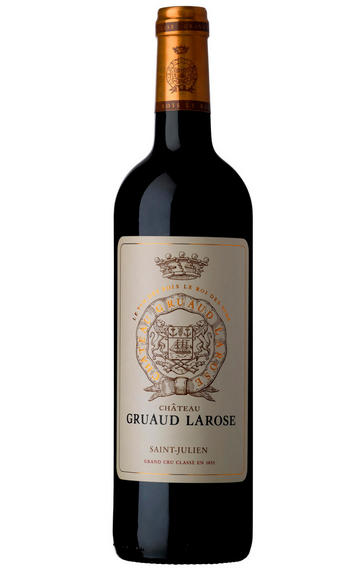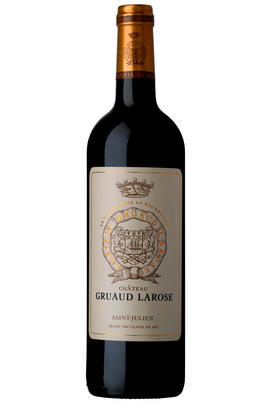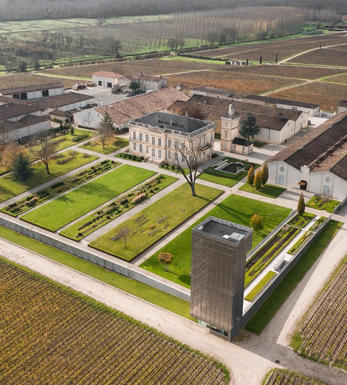
2016 Château Gruaud Larose, St Julien, Bordeaux

Critics reviews
Drink 2033+
Burghound (Apr 2018)
Lisa Perrotti-Brown - 30/11/2018
Drink 2030-2045
Jancis Robinson MW, jancisrobinson.com (Nov 2016)
James Suckling - April 2017
About this WINE

Chateau Gruaud Larose
Château Gruaud-Larose is a 2ème Cru Classé property that produces one of St-Julien's most full-bodied and long-lived wines.
For many years Gruaud-Larose was owned by the négociants Cordier, who also own Château Talbot. It was sold in 1993 to the French conglomerate, Alcastel Alstom, which in turn sold it to the Taillan Group, owners of Chasse-Spleen and Haut-Bages-Libéral, in 1997. The talented Georges Pauli has remained as régisseur and winemaker throughout all these changes.
Gruaud-Larose has 84 hectares of vineyards located on a gravel-rich plateau just to the west of Château Beychevelle. The wine is a blend of Cabernet Sauvignon (65%), Merlot (25%), Cabernet Franc (8%) and Petit Verdot (2%). Vinification takes place in a mixture of wooden vats and cement tanks and the wine is aged in oak barriques (30% new) for 18 months.
Gruaud-Larose can be tannic and ungainly in youth but with bottle ageing it becomes marvellously harmonious and develops complex and beguiling characteristics of concentrated black fruits, cedar, spices and liquorice.

St Julien
St Julien is the smallest of the "Big Four" Médoc communes. Although, without any First Growths, St Julien is recognised to be the most consistent of the main communes, with several châteaux turning out impressive wines year after year.
St Julien itself is much more of a village than Pauillac and almost all of the notable properties lie to its south. Its most northerly château is Ch. Léoville Las Cases (whose vineyards actually adjoin those of Latour in Pauillac) but, further south, suitable vineyard land gives way to arable farming and livestock until the Margaux appellation is reached.
The soil is gravelly and finer than that of Pauillac, and without the iron content which gives Pauillac its stature. The homogeneous soils in the vineyards (which extend over a relatively small area of just over 700 hectares) give the commune a unified character.
The wines can be assessed as much by texture as flavour, and there is a sleek, wholesome character to the best. Elegance, harmony and perfect balance and weight, with hints of cassis and cedar, are what epitomise classic St Julien wines. At their very best they combine Margaux’s elegance and refinement with Pauillac’s power and substance.
Ch. Léoville Las Cases produces arguably the most sought-after St Julien, and in any reassessment of the 1855 Classification it would almost certainly warrant being elevated to First Growth status.
Recommended Châteaux: Ch. Léoville Las Cases, Ch.Léoville Barton, Ch Léoville Poyferré, Ch. Ducru-Beaucaillou, Ch Langoa Barton, Ch Gruaud Larose, Ch. Branaire-Ducru, Ch. Beychevelle

Cabernet Sauvignon Blend
Cabernet Sauvignon lends itself particularly well in blends with Merlot. This is actually the archetypal Bordeaux blend, though in different proportions in the sub-regions and sometimes topped up with Cabernet Franc, Malbec, and Petit Verdot.
In the Médoc and Graves the percentage of Cabernet Sauvignon in the blend can range from 95% (Mouton-Rothschild) to as low as 40%. It is particularly suited to the dry, warm, free- draining, gravel-rich soils and is responsible for the redolent cassis characteristics as well as the depth of colour, tannic structure and pronounced acidity of Médoc wines. However 100% Cabernet Sauvignon wines can be slightly hollow-tasting in the middle palate and Merlot with its generous, fleshy fruit flavours acts as a perfect foil by filling in this cavity.
In St-Emilion and Pomerol, the blends are Merlot dominated as Cabernet Sauvignon can struggle to ripen there - when it is included, it adds structure and body to the wine. Sassicaia is the most famous Bordeaux blend in Italy and has spawned many imitations, whereby the blend is now firmly established in the New World and particularly in California and Australia.


Buying options
Add to wishlist
Description
This is another very good effort from this historic second growth. Notes of plum and soft red fruit on the nose give way to a palate of crunchy red fruit and nicely melded tannins. The palate is suave and fresh with a grainy length and fresh finish. A very good Claret this year.
Blend: Cabernet Sauvignon 65%, Merlot 25%, Cabernet Franc 5%, Petit Verdot 5%
wine at a glance
Delivery and quality guarantee